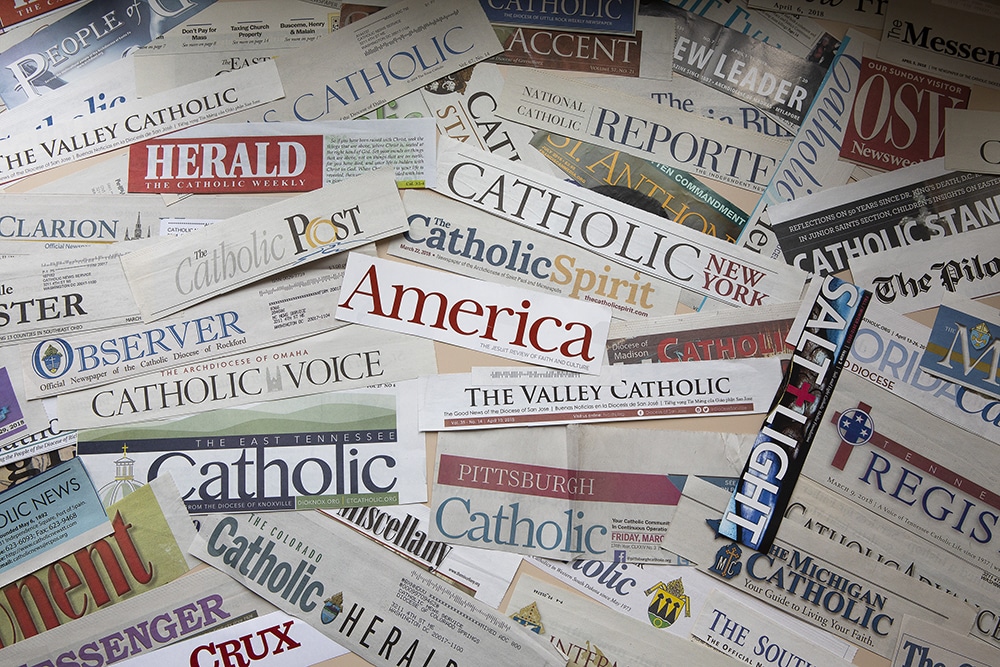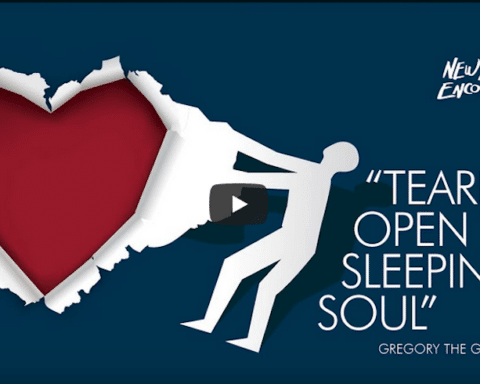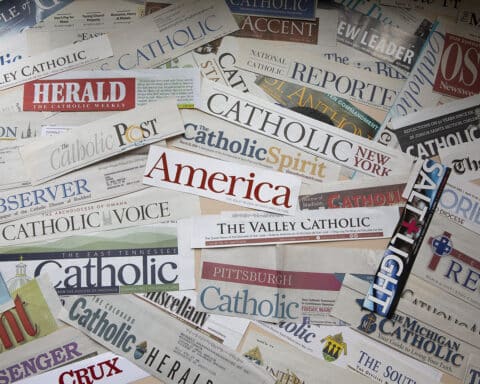There could be many diocesan newspapers and Catholic magazines that “never totally recover” from the coronavirus pandemic’s economic stranglehold, said J.D. Long-Garcia.
“I think this will have a permanent impact on how we do business,” said Long-Garcia, a senior editor at America Media who also serves as president of the Catholic Press Association.
Long-Garcia told Our Sunday Visitor that he was not surprised with last month’s announcement that the Diocese of Pittsburgh was shutting down its 165-year-old weekly newspaper, The Pittsburgh Catholic. He was also not shocked with the April 9 press release from Bayard Inc., an international Catholic publishing company, that it would soon stop printing four magazines, including Catholic Digest.
“There are some publications that won’t make it through this crisis, and I hope in those instances that Catholic communications continue,” Long-Garcia said “I hope as much as possible that there continues to be publications, because I think they’re a critical touch-point with the Church.”
A shift in approach
Even before the pandemic prompted most governors in the United States to effectively shut down the nation’s economy through stay-at-home orders and mandates to close nonessential businesses, the Catholic media industry was already going through challenging financial times.
New technology and modern news consumers’ preference for online media have been prompting Catholic publications, like their secular counterparts, to move from a traditional print model to a digital-first, multimedia platform.
“We may find that (the pandemic) will propel more of our publications into more of a digital format, digital distribution model. We may see that happen,” said Tim Walter, the executive director of the Catholic Press Association.
The shift may be necessary, but the economics have not caught up. Publications that relied on print advertising for some or most of their revenue have struggled because online advertising is not as lucrative. At the same time, the growing expenses of printing and mailing have further complicated the problem of how to balance the books.
“I think since the 2008 financial crisis, we’ve seen extraordinary pressures placed on the Church and Church institutions, which I thought we might have been climbing out of before the COVID-19 pandemic,” said Greg Erlandson, director and editor-in-chief of Catholic News Service.
With online advertising these days mainly going to tech giants like Google and Facebook, Erlandson said that Catholic publications had already been trying to adapt to the new economic reality through new strategies and cost-saving measures such as distributing newspapers through parishes instead of mailing them to subscribers.
“But now with the parishes being shut down, that has a hugely negative impact as well,” said Erlandson, who is the former president and publisher of Our Sunday Visitor.
Facing tough times
In Pittsburgh, the diocese relied on parishes to distribute the newspaper. But when Bishop David A. Zurik ordered the Steel City’s churches to be closed in mid-March, the diocese had no way to get The Pittsburgh Catholic out to its readership.
“Parishes’ Masses were the main distribution point for the paper,” Ellen Mady, the chancellor for the Diocese of Pittsburgh, told Our Sunday Visitor in an email. The diocese suspended its newspaper March 19, four days after the bishop’s announcement.
Mady said that without the newspaper, the Pittsburgh diocese is now focusing on strengthening its online presence through the diocesan website, social media, online streaming and email newsletters. Mady said the diocese has seen “major growth in engagement” in all those areas.
“As we move forward, we will continue to evaluate options for communication channels, taking into account the latest information and guidelines available to us through local, state and national authorities,” Mady said.
Asked if the diocese would consider bringing back its newspaper or having a digital platform where journalism would be used to tell the local Church’s story, Mady said: “We know how much people love hearing positive stories about their faith, and we want to keep those going. So yes, we’ll be looking at all options moving forward.”
In Arizona, the Diocese of Tucson’s monthly newspaper, The Catholic Outlook, is also facing an uncertain future. The suspension of public Masses not only chokes off a major distribution point for the newspaper, it also deprives the local Church of the lion’s share of its income.
“We think we’re going to have a substantial budget shortfall, about $2 million, so we’re trying to be prudent in how we take care of our employees,” Father John Arnold, moderator of the curia for the Diocese of Tucson.
Father Arnold said the diocese obtained a small business forgivable loan through the federal CARES Act — a coronavirus relief program — that allowed the diocese to restore all furloughed employees to their salary levels. However, the funding runs out in mid-June, and the diocese’s financial situation will still be shaky at best.
As of now, the diocese has not made any decision about The Catholic Outlook, which is down to two staff members. Father Arnold said the Diocese of Tucson is just looking to make it through the next fiscal year.
“The Catholic press is extremely important,” Father Arnold said. “But how do we pull (funding the newspaper) off when there are so many other things the Church does that are essential?”
Telling the Church’s story
Secular media observers have begun using the term “news deserts” to describe the growing number of communities that have lost their local newspapers. Walter, the executive director of the Catholic Press Association, said he has “major concerns” about a Catholic equivalent.
“Our publications help get out the good things that diocesan ministries do, whether its schools, Hispanic outreach, stewardship. … Our publications tell those stories. There is still a vital need for that,” said Walter, who told Our Sunday Visitor that diocesan newspapers in particular communicate the Church’s story in a way that eludes the secular media.
“That’s because secular media attracts attention through sensation. That’s not what the Catholic press is about,” said Walter, who added that the Catholic Press Association has formed a task force to reach out to bishops and their communications directors.
“We hope to tell bishops, ‘Before you make a drastic move like (closing the newspaper), please contact the Catholic Press Association to find out if there are resources with which we can help you,'” Walter said. “Maybe you don’t need five full-time staff. Maybe you go down to three full-time staff and you outsource some work to other diocesan members.”
Erlandson, of Catholic News Service, said he “would hate to see” more dioceses stop publishing their own newspapers, because “the Church cannot rely on secular media to communicate its message.”
“I think there’s a reason the Catholic newspaper developed in the first place,” Erlandson said. “It communicates to the larger world the views of the Church and the positions of the Church. Just as important, it communicates that to Catholics themselves so that they know there’s a Catholic position, and that they know every single day Pope Francis is addressing the COVID-19 pandemic and its implications for people, and that every single day Catholics are working to address this plague.”
Long-Garcia, the Catholic Press Association president, said he understands Church officials are having to make difficult financial decisions related to the pandemic. However, he believes bishops should still prioritize a communications strategy that uses journalism.
Said Long-Garcia, “I think the Church needs to tell her own story.”
Brian Fraga is a contributing editor for Our Sunday Visitor.





